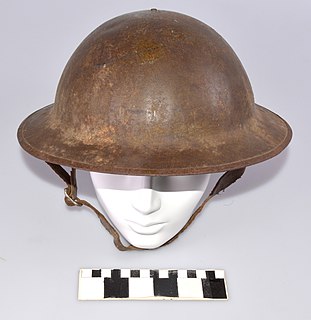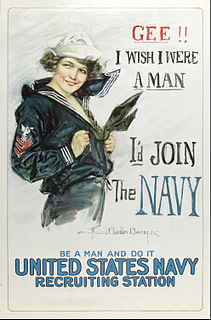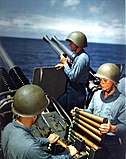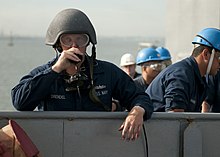
The San Antonio class is a class of amphibious transport docks, also called a "landing platform, dock" (LPD), used by the United States Navy. These warships replace the Austin-class LPDs, as well as the Newport-class tank landing ships, and the Charleston-class amphibious cargo ships that have already been retired.

USS Wasp (LHD-1) is a United States Navy multipurpose amphibious assault ship, and the lead ship of her class. She is the tenth USN vessel to bear the name since 1775, with the last two ships named Wasp being aircraft carriers. She was built by the Ingalls Shipbuilding division of Litton in Pascagoula, Mississippi. Wasp and her sister ships are the first specifically designed to accommodate new Landing Craft Air Cushion (LCAC) for fast troop movement over the beach, and Harrier II (AV-8B) Vertical/Short Take-Off and Landing (V/STOL) jets which provide close air support for the assault force. She can also accommodate the full range of Navy and Marine Corps helicopters, the tiltrotor MV-22 Osprey, the F-35B Lightning II multi-role fighter, conventional landing craft, and amphibious vehicles.

The Fleet Rehabilitation and Modernization (FRAM) program of the United States Navy extended the lives of World War II-era destroyers by shifting their mission from a surface attack role to that of a submarine hunter. The FRAM program also covered cruisers, aircraft carriers, submarines, amphibious ships, and auxiliaries. The United States Coast Guard also used this term in the 1980s for the modernization of its Hamilton-class cutters.

The Brodie helmet is a steel combat helmet designed and patented in London in 1915 by John Leopold Brodie. A modified form of it became the Helmet, Steel, Mark I in Britain and the M1917 Helmet in the US. Colloquially, it was called the shrapnel helmet, battle bowler, Tommy helmet, tin hat, and in the United States the doughboy helmet. It was also known as the dishpan hat, tin pan hat, washbasin and Kelly helmet. The German Army called it the Salatschüssel. The term Brodie is often misused. It is correctly applied only to the original 1915 Brodie's Steel Helmet, War Office Pattern.

The Stahlhelm is a German military steel combat helmet intended to provide protection against shrapnel and fragments of grenades. The term Stahlhelm refers both to a generic steel helmet and more specifically to the distinctive German military design.

Personnel Armor System for Ground Troops is a combat helmet and ballistic vest that was used by the United States military from the early 1980s until the mid-2000s, when the helmet and vest were succeeded by the Lightweight Helmet (LWH), Modular Integrated Communications Helmet (MICH), and Interceptor Body Armor (IBA) respectively.

The M1 helmet is a combat helmet that was used by the U.S. military from World War II until 1985, when it was succeeded by the PASGT helmet. The M1 helmet has become an icon of the US military, with its design inspiring other militaries around the world.

The Special Naval Landing Forces were naval infantry units of the Imperial Japanese Navy (IJN) and were a part of the IJN Land Forces. They saw extensive service in the Second Sino-Japanese War and the Pacific theatre of World War II.

The Republic of China Navy, also called the ROC Navy and colloquially the Taiwan Navy, is the maritime branch of the Republic of China Armed Forces (ROCAF).

The Gyrodyne QH-50 DASH is a small drone helicopter built by Gyrodyne Company of America for use as a long-range anti-submarine weapon on ships that would otherwise be too small to operate a full-sized helicopter. It remained in production until 1969. Several are still used today for various land-based roles.

The Modular Integrated Communications Helmet (MICH) is a U.S. combat helmet and one of several used by the U.S. military. It was developed by the United States Army Soldier Systems Center to be the next generation of protective combat helmets for use by the U.S. Army.

The uniforms of the United States Navy include dress uniforms, daily service uniforms, working uniforms, and uniforms for special situations, which have varied throughout the history of the navy. For simplicity in this article, officers refers to both commissioned officers and warrant officers.

The RIM-66 Standard MR (SM-1MR/SM-2MR) is a medium-range surface-to-air missile (SAM), with a secondary role as an anti-ship missile, originally developed for the United States Navy (USN). A member of the Standard Missile family of weapons, the SM-1 was developed as a replacement for the RIM-2 Terrier and RIM-24 Tartar that were deployed in the 1950s on a variety of USN ships. The RIM-67 Standard (SM-1ER/SM-2ER) is an extended range version of this missile with a solid rocket booster stage.

The Mk III Helmet was a steel military combat helmet first developed for the British Army in 1941 by the Medical Research Council. First worn in combat by British and Canadian troops on D-Day, the Mk III and Mk IV were used alongside the Brodie helmet for the remainder of the Second World War. It is sometimes referred to as the "turtle" helmet by collectors, because of its vague resemblance to a turtle shell, as well as the 1944 pattern helmet.

The United States Navy (USN) is the maritime service branch of the United States Armed Forces and one of the eight uniformed services of the United States. It is the largest and most powerful navy in the world, with the estimated tonnage of its active battle fleet alone exceeding the next 13 navies combined, including 11 allies or partner nations of the United States as of 2015. It has the highest combined battle fleet tonnage and the world's largest aircraft carrier fleet, with eleven in service, two new carriers under construction, and five other carriers planned. With 336,978 personnel on active duty and 101,583 in the Ready Reserve, the United States Navy is the third largest of the United States military service branches in terms of personnel. It has 290 deployable combat vessels and more than 2,623 operational aircraft as of June 2019.
The New Zealand Army uniform has changed over the years from that of the original Armed Constabulary of the 1800s to the modern Army Combat Uniform style in use by the majority of world armies today. While British Army influence has always been strong, distinctive New Zealand features have gradually developed. From 2013 the New Zealand Army uniform underwent a complete redesign with a new and distinctive camouflage pattern unique to the NZDF.

The Royal Marines uniform is the standardised military dress worn by members of the Royal Marines.

The American fiber helmet is a type of sun helmet made of pressed fiber material that has been used as part of the military uniform by various parts of the United States Armed Forces, from 1934 to present. As of 2017, the helmet continues to be worn by US military rifle range cadres, as an icon for marksmanship excellence. The helmet is technically not a pith helmet, insofar as it is not constructed from pith material. However, in the more generic sense of design style, this type of sun helmet is modeled similarly to one and thus often referred to in common use as a pith helmet. Additionally, the helmet is not a combat helmet, insofar as it was not originally designed to protect the head during combat. However, the helmet was nonetheless assigned, at various times in the 1930s and 1940s, as combat gear for use in active theaters.
The Navy Working Uniform (NWU) is a series of military uniforms that are currently used by the United States Navy for wear by its members. The NWU is a "working" uniform, which means that it is made to a more durable and utilitarian standard, thus being worn in lieu of more formal uniforms that might get unduly damaged or dirtied in the process of normal military duties.



















